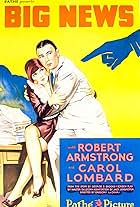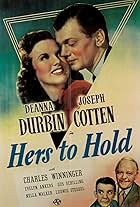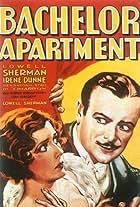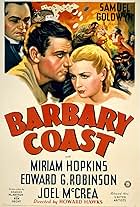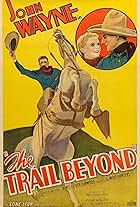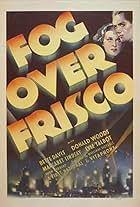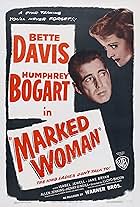
lugonian
Joined Sep 2000
Welcome to the new profile
We're still working on updating some profile features. To see the badges, ratings breakdowns, and polls for this profile, please go to the previous version.
Ratings1.2K
lugonian's rating
Reviews1.2K
lugonian's rating
BIG NEWS (Pathe, 1929), directed by Gregory LaCava, is vintage/early talkie newspaper melodrama taken from the stage play reportedly titled "For Two Cents" by George S. Brooks. Probably inspired by the more famous Ben Hecht / Charles MacArthur 1928 play of The Front Page" that became the basis of the 1931 screen adaptation starring Adolphe Menjou and Pat O'Brien, BIG NEWS (its new yet more appropriate title) stars Robert Armstrong in a stage to screen adaptation set mostly inside an editorial room/office with reporter/editor/publisher types giving that actual newsroom feel with stories behind it.
Plot development introduces the workers of The Express newspaper as they start off their rainy morning in the editorial room: Hansel (Louis Payne), the publisher; J. W. Addison (Charles Sellon), the editor-in-chief who's hard of hearing; Vera (Cupid Ainsworth), a heavy-set manly-dressed columnist of advice to the lovelorn column; O'Neill (Wade Boteler) the city editor, and Steve Banks (Robert Armstrong), a reporter found sobering up on the sofa inside Addison's office. With his weakness for liquor, Steve's strength is getting the scoop, although his wife, Margaret (Carol Lombard), working for the Morning Herald, has out scooped him with her narcotics ring story he is assigned to do. Married two years, Margaret comes to the office to tell Steve she wants a divorce. Though she feels he's a great reporter, she finds him irresponsible and refuses to wait to see him reach the drunken path of fellow reporter Deke Thomas (James Donlan). Although there are others who want Steve Banks fired, it's Joe Reno (Sam Hardy), its leading advertiser and owner of a neighboring speakeasy, The Reno Cafe, who arranges that for suspecting Steve's hunches are getting too close to the truth about him. Told by Addison he's nothing but a bum newspaperman and insult to his profession, Steve angrily walks out of the office to prove his theories about him are false. Acquiring a written statement from a Rose Perotti that could put Reno and his gang to prison, Banks returns to find Addison's office with police, co-workers and all the evidence pointed towards Steve for his murder for which he is innocent.
Other members of the cast include Warner Richmond (District Attorney Phelps), Gertrude Sutton (Helen), Clarence Wilson (The Coroner) and Tom Kennedy (Thomas Ryan), a police officer whose name is purposely misspelled in articles written by Steve Banks. Look quickly for future film stars as George, later "Gabby" Hayes (sans beard) of movie westerns fame Hoffman, a reporter; and the youthful Lew Ayres briefed in two scenes as a copy boy.
Unlike most early talkies from 1929, the 66-minute edition of BIG NEWS is faster-paced than most, thanks to the fine direction by Gregory LaCava, best known for his comedy classic MY MAN GODFREY (Universal, 1936) that co-starred Carole Lombard (billed Carol in BIG NEWS) whose madcap performance earned her her only Academy Award nomination as Best Actress.
While Armstrong and Lombard were paired in total of four movies during the 1928-29 season, to date, BIG NEWS and THE RACKETEER (1929) are the only ones available for viewing either on limited video cassette or DVD format releases. (*** Bylines)
Plot development introduces the workers of The Express newspaper as they start off their rainy morning in the editorial room: Hansel (Louis Payne), the publisher; J. W. Addison (Charles Sellon), the editor-in-chief who's hard of hearing; Vera (Cupid Ainsworth), a heavy-set manly-dressed columnist of advice to the lovelorn column; O'Neill (Wade Boteler) the city editor, and Steve Banks (Robert Armstrong), a reporter found sobering up on the sofa inside Addison's office. With his weakness for liquor, Steve's strength is getting the scoop, although his wife, Margaret (Carol Lombard), working for the Morning Herald, has out scooped him with her narcotics ring story he is assigned to do. Married two years, Margaret comes to the office to tell Steve she wants a divorce. Though she feels he's a great reporter, she finds him irresponsible and refuses to wait to see him reach the drunken path of fellow reporter Deke Thomas (James Donlan). Although there are others who want Steve Banks fired, it's Joe Reno (Sam Hardy), its leading advertiser and owner of a neighboring speakeasy, The Reno Cafe, who arranges that for suspecting Steve's hunches are getting too close to the truth about him. Told by Addison he's nothing but a bum newspaperman and insult to his profession, Steve angrily walks out of the office to prove his theories about him are false. Acquiring a written statement from a Rose Perotti that could put Reno and his gang to prison, Banks returns to find Addison's office with police, co-workers and all the evidence pointed towards Steve for his murder for which he is innocent.
Other members of the cast include Warner Richmond (District Attorney Phelps), Gertrude Sutton (Helen), Clarence Wilson (The Coroner) and Tom Kennedy (Thomas Ryan), a police officer whose name is purposely misspelled in articles written by Steve Banks. Look quickly for future film stars as George, later "Gabby" Hayes (sans beard) of movie westerns fame Hoffman, a reporter; and the youthful Lew Ayres briefed in two scenes as a copy boy.
Unlike most early talkies from 1929, the 66-minute edition of BIG NEWS is faster-paced than most, thanks to the fine direction by Gregory LaCava, best known for his comedy classic MY MAN GODFREY (Universal, 1936) that co-starred Carole Lombard (billed Carol in BIG NEWS) whose madcap performance earned her her only Academy Award nomination as Best Actress.
While Armstrong and Lombard were paired in total of four movies during the 1928-29 season, to date, BIG NEWS and THE RACKETEER (1929) are the only ones available for viewing either on limited video cassette or DVD format releases. (*** Bylines)
SIDE STREET (RKO Radio, 1929), written and directed by Malcolm St. Clair, is an early talkie starring natural Irish brothers playing fictional Irish siblings. Starring the Moore Brothers (not the Marx Brothers) featuring Tom, Owen and Matt, it's a dramatic story filmed like a stage play set in apartments with limited intercut street scenes and no underscoring, not even during the opening and closing credits. In spite of these handicaps for anyone accustomed for more improved methods found through the development in latter sound movies, SIDE STREET is something to consider for what it has to offer: all dialogue, a dancing sequence performed by the uncredited future star actor by the name of George Raft.
Set in New York City, the plot development begins in the apartment of the O'Farrell family: Mr. O'Farrell (Frank Sheridan), retired police officer with wife, Nora (Emma Dunn), devoted mother of three grown sons: Jimmy (Tom Moore), a policeman; John (Matt Moore), educated in medical school with the help of his older brother, Dennis (Owen Moore), a piano player and businessman by profession. With Jimmy discussing with his father about gangland killings headed by mobster Barney Muller, a shooting occurs during their dinner gathering outside their building. Jim Burke, a friend of the family is identified and believed to be the murder victim by the Muller mob. Engaged to Kathleen Doyle (Kathryn Perry), Jimmy finally gets his promotion to plainclothesman detective with his first assignment being the investigation on the Muller case. As Kathleen returns home with her friend Bunny (Mildred Harris), they are invited by Max Kimball (Charles Byer) to attend a Park Avenue cocktail party. While here, Kathleen not only meets up with the notorious Barney Muller, so does John arriving on ambulance duty to take in Pinky (Dan Wolheim), an injured guest with skull fracture to the hospital. For reasons of their own, both decide to keep Muller's identity a secret from Jimmy.
Other members in the cast include Arthur Housman, Walter McNamara, Al Hill, Heinie Conklin and Raymond Turner. Aside from the story coming to life with the presence of then unknown George Raft (as Georgie Ames), there's nice vocalization by June Clyde (as Judy) with chorus girls dancing to "Take a Look at Her Now." Aside from George Raft's solo dancing in the best George Raft style, he does have some spoken dialogue in the story as well set during the cocktail party sequence. How fortunate SIDE STREET has survived intact all these years or else it would have never been known that George Raft ever appeared in this virtually unknown production.
With the careers of the three Moore brothers dating back to the earliest days of the silent era, their transition to talkies were well established, but by 1929 they were no longer popular individual leading men as they were back decades ago.
Probably due to primitive production style of spoken dialogue echoes and lack of marquee names by today's standards have limited SIDE STREET from ever being televised. Regardless of its age, SIDE STREET does have some interesting touches found in early talkies, namely an individual scene where two brothers are conversing while the other is on telephone in the background, hearing all three voices talking over one another, making it evident that talkies are here to stay.
Never distributed on video cassette nor DVD format, SIDE STREET did have some limited cable television broadcasts over the years: American Movie Classics (1988-1991) and Turner Classic Movies. Story material might have proved beneficial had SIDE STREET been remade as a second feature in the late thirties possibly casting Preston Foster in the lead, with better film-making technology and pacing that would have improved over its original. As it stands now, this is the one and only. (**1/2)
Set in New York City, the plot development begins in the apartment of the O'Farrell family: Mr. O'Farrell (Frank Sheridan), retired police officer with wife, Nora (Emma Dunn), devoted mother of three grown sons: Jimmy (Tom Moore), a policeman; John (Matt Moore), educated in medical school with the help of his older brother, Dennis (Owen Moore), a piano player and businessman by profession. With Jimmy discussing with his father about gangland killings headed by mobster Barney Muller, a shooting occurs during their dinner gathering outside their building. Jim Burke, a friend of the family is identified and believed to be the murder victim by the Muller mob. Engaged to Kathleen Doyle (Kathryn Perry), Jimmy finally gets his promotion to plainclothesman detective with his first assignment being the investigation on the Muller case. As Kathleen returns home with her friend Bunny (Mildred Harris), they are invited by Max Kimball (Charles Byer) to attend a Park Avenue cocktail party. While here, Kathleen not only meets up with the notorious Barney Muller, so does John arriving on ambulance duty to take in Pinky (Dan Wolheim), an injured guest with skull fracture to the hospital. For reasons of their own, both decide to keep Muller's identity a secret from Jimmy.
Other members in the cast include Arthur Housman, Walter McNamara, Al Hill, Heinie Conklin and Raymond Turner. Aside from the story coming to life with the presence of then unknown George Raft (as Georgie Ames), there's nice vocalization by June Clyde (as Judy) with chorus girls dancing to "Take a Look at Her Now." Aside from George Raft's solo dancing in the best George Raft style, he does have some spoken dialogue in the story as well set during the cocktail party sequence. How fortunate SIDE STREET has survived intact all these years or else it would have never been known that George Raft ever appeared in this virtually unknown production.
With the careers of the three Moore brothers dating back to the earliest days of the silent era, their transition to talkies were well established, but by 1929 they were no longer popular individual leading men as they were back decades ago.
Probably due to primitive production style of spoken dialogue echoes and lack of marquee names by today's standards have limited SIDE STREET from ever being televised. Regardless of its age, SIDE STREET does have some interesting touches found in early talkies, namely an individual scene where two brothers are conversing while the other is on telephone in the background, hearing all three voices talking over one another, making it evident that talkies are here to stay.
Never distributed on video cassette nor DVD format, SIDE STREET did have some limited cable television broadcasts over the years: American Movie Classics (1988-1991) and Turner Classic Movies. Story material might have proved beneficial had SIDE STREET been remade as a second feature in the late thirties possibly casting Preston Foster in the lead, with better film-making technology and pacing that would have improved over its original. As it stands now, this is the one and only. (**1/2)
THE RACKETEER (Pathe, 1929), directed by Howard Higgin, stars Robert Armstrong (best known as Carl Denham in the 1933 classic of KING KONG) in the title role of a New York City crime boss. Not the typical rise and fall gangster drama made famous in later years by Edward G. Robinson, James Cagney, George Raft or Humphrey Bogart, but more focus on a mob boss's love for an ex-debutante than gangster activities.
Starting off with an aerial view of New York City landmarks as the Brooklyn Bridge, the story opens with a drunken panhandler (Roland Drew) violin playing on the streets for money. Mehaffey (Paul Hurst), a policeman on the beat attempts arresting the man for vagrancy until Mahlon Keane (Robert Armstrong) comes over to give the panhandler $50 and a taxi ride over to "the Ritz." Inside the passing taxi happens to be Rhoda Philbrooke (Carol Lombard) who claims not only to know the vagrant but takes him to her cab back to her apartment. It is later learned that Rhoda is the ex-wife of the famed violinist Anthony "Tony" Vaughan. Still in love with him, she struggles in helping Tony recover from his alcoholic binges. Attending a benefit for St. James Orphanage on East 92nd Street sponsored by Keane and hosted by Karen Lee (Hedda Hopper) using Monte Carlo settings for gambling guests, Rhoda is soon greeted and invited Jack Oakhurst (John Loder) to join him and the other guests including Millie Chapman (Jeanette Loff), Sam Chapman (Winter Hall), Margaret Simpson (Winifred Harris) and Mahlon Keane for a game of poker. After noticing Rhoda cheating at cards to win extra money for her winnings, Mahlon speaks on her behalf making it appear she won the game honestly. Unable to forget this attractive woman, Mahlon comes to Rhoda's Hayward Apartment residence on West 68th Street to tell her how he feels. Realizing Rhoda in desperate need assisting for Tony's medical expenses, Mahlon finances her with enough money and treatment. Completely cured, Tony resumes his career in violin recitals at concert halls. Learning Tony has no further use for Rhoda, Mahlon considers asking Rhoda for her hand in marriage but wonders if she will accept him for his notorious reputation. Other members of the cast include Kit Guard (Gus); Buddy Fine (Bernie Weber); Al Hill (Squid, the Chauffeur); and Bobbie Dunn (The Rat).
With the exception of opening credits, THE RACKETEER is virtually scoreless and leisurely paced for much of its 65 minutes. The story in itself is not bad though for a crime movie sounding title one would expect a handful of visual gangland killings for added interest. Robert Armstrong is fine but doesn't seem believable as the crime boss in the manner of Louis Wolheim had he been chosen for the title role. Though not great nor an important part in cinema history, its sole reason for viewing this early talkie is the presence of Carol (minus the "e" added to her first name in credits) Lombard early in her career.
Fortunate to have survived intact after all these years, THE RACKETEER didn't start circulating until 1998 when first broadcast on public television followed by availability on DVD and cable television's Turner Classic Movies (TCM premiere: August 17, 2006) and on demand from MGM Plus. (**)
Starting off with an aerial view of New York City landmarks as the Brooklyn Bridge, the story opens with a drunken panhandler (Roland Drew) violin playing on the streets for money. Mehaffey (Paul Hurst), a policeman on the beat attempts arresting the man for vagrancy until Mahlon Keane (Robert Armstrong) comes over to give the panhandler $50 and a taxi ride over to "the Ritz." Inside the passing taxi happens to be Rhoda Philbrooke (Carol Lombard) who claims not only to know the vagrant but takes him to her cab back to her apartment. It is later learned that Rhoda is the ex-wife of the famed violinist Anthony "Tony" Vaughan. Still in love with him, she struggles in helping Tony recover from his alcoholic binges. Attending a benefit for St. James Orphanage on East 92nd Street sponsored by Keane and hosted by Karen Lee (Hedda Hopper) using Monte Carlo settings for gambling guests, Rhoda is soon greeted and invited Jack Oakhurst (John Loder) to join him and the other guests including Millie Chapman (Jeanette Loff), Sam Chapman (Winter Hall), Margaret Simpson (Winifred Harris) and Mahlon Keane for a game of poker. After noticing Rhoda cheating at cards to win extra money for her winnings, Mahlon speaks on her behalf making it appear she won the game honestly. Unable to forget this attractive woman, Mahlon comes to Rhoda's Hayward Apartment residence on West 68th Street to tell her how he feels. Realizing Rhoda in desperate need assisting for Tony's medical expenses, Mahlon finances her with enough money and treatment. Completely cured, Tony resumes his career in violin recitals at concert halls. Learning Tony has no further use for Rhoda, Mahlon considers asking Rhoda for her hand in marriage but wonders if she will accept him for his notorious reputation. Other members of the cast include Kit Guard (Gus); Buddy Fine (Bernie Weber); Al Hill (Squid, the Chauffeur); and Bobbie Dunn (The Rat).
With the exception of opening credits, THE RACKETEER is virtually scoreless and leisurely paced for much of its 65 minutes. The story in itself is not bad though for a crime movie sounding title one would expect a handful of visual gangland killings for added interest. Robert Armstrong is fine but doesn't seem believable as the crime boss in the manner of Louis Wolheim had he been chosen for the title role. Though not great nor an important part in cinema history, its sole reason for viewing this early talkie is the presence of Carol (minus the "e" added to her first name in credits) Lombard early in her career.
Fortunate to have survived intact after all these years, THE RACKETEER didn't start circulating until 1998 when first broadcast on public television followed by availability on DVD and cable television's Turner Classic Movies (TCM premiere: August 17, 2006) and on demand from MGM Plus. (**)
